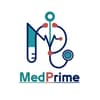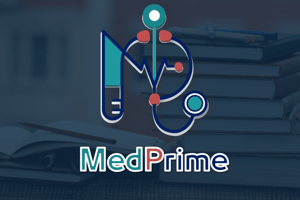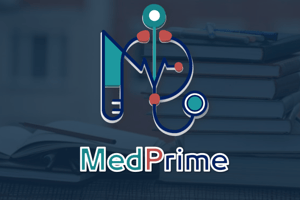Podcast
Questions and Answers
How many heme groups and globin chains are present in one molecule of adult hemoglobin (HbA)?
How many heme groups and globin chains are present in one molecule of adult hemoglobin (HbA)?
What types of globin chains are found in adult hemoglobin (HbA)?
What types of globin chains are found in adult hemoglobin (HbA)?
How many amino acids are present in an alpha chain of globin?
How many amino acids are present in an alpha chain of globin?
In the last step of heme synthesis, iron is attached to protoporphyrin IX. What is the oxidation state of iron in this step?
In the last step of heme synthesis, iron is attached to protoporphyrin IX. What is the oxidation state of iron in this step?
Which enzyme catalyzes the last step of heme synthesis?
Which enzyme catalyzes the last step of heme synthesis?
What is the normal concentration of hemoglobin in adult males?
What is the normal concentration of hemoglobin in adult males?
Which type of hemoglobin constitutes the majority of adult hemoglobin?
Which type of hemoglobin constitutes the majority of adult hemoglobin?
How many globin chains are present in a hemoglobin molecule?
How many globin chains are present in a hemoglobin molecule?
What is the function of hemoglobin?
What is the function of hemoglobin?
Which of the following is NOT a hemoprotein?
Which of the following is NOT a hemoprotein?
Where does the majority of heme synthesis occur?
Where does the majority of heme synthesis occur?
Which cellular compartments are involved in heme synthesis?
Which cellular compartments are involved in heme synthesis?
What are the starting materials for the synthesis of ALA (the first step in heme synthesis)?
What are the starting materials for the synthesis of ALA (the first step in heme synthesis)?
Which enzyme catalyzes the rate-limiting step in heme synthesis?
Which enzyme catalyzes the rate-limiting step in heme synthesis?
What is the effect of lead poisoning on heme synthesis?
What is the effect of lead poisoning on heme synthesis?
Explain the structural organization of adult hemoglobin (HbA).
Explain the structural organization of adult hemoglobin (HbA).
What is the role of iron in the heme molecule?
What is the role of iron in the heme molecule?
Describe the key regulatory mechanism of heme synthesis.
Describe the key regulatory mechanism of heme synthesis.
What are porphyrias, and what causes them?
What are porphyrias, and what causes them?
Differentiate between erythropoietic porphyria and hepatic porphyria.
Differentiate between erythropoietic porphyria and hepatic porphyria.
How does lead poisoning interfere with heme synthesis?
How does lead poisoning interfere with heme synthesis?
What are the clinical manifestations of porphyrias?
What are the clinical manifestations of porphyrias?
How is the diagnosis of porphyrias made?
How is the diagnosis of porphyrias made?
What is the difference between heme and hemin?
What is the difference between heme and hemin?
How is heme synthesis regulated in the liver compared to erythroid cells?
How is heme synthesis regulated in the liver compared to erythroid cells?
What is the function of cytochrome P450?
What is the function of cytochrome P450?
Why is the first step in heme synthesis considered the key regulatory step?
Why is the first step in heme synthesis considered the key regulatory step?
What is the role of ALA dehydratase in heme synthesis?
What is the role of ALA dehydratase in heme synthesis?
A patient presents with photosensitivity and skin rash. Which type of porphyria is most likely?
A patient presents with photosensitivity and skin rash. Which type of porphyria is most likely?
Explain why glucose inhibits heme synthesis in the liver.
Explain why glucose inhibits heme synthesis in the liver.
Rate limiting step in porphyrin synthesis is?
Rate limiting step in porphyrin synthesis is?
Rate limiting enzyme in heme synthesis?
Rate limiting enzyme in heme synthesis?
All of the following are precursors of heme except?
All of the following are precursors of heme except?
HbA differs from HbF in that?
HbA differs from HbF in that?
Flashcards are hidden until you start studying
Study Notes
Red Blood Cell Structure and Lifespan
- Red blood cells (RBCs) are shaped like a biconcave disc, optimizing surface area for gas exchange.
- Average lifespan of RBCs in peripheral circulation is approximately 120 days.
- RBCs are primarily synthesized in the bone marrow.
Composition of Red Blood Cells
- Mature RBCs lack organelles such as nuclei and mitochondria.
- The main function of RBCs is to transport oxygen and carbon dioxide throughout the body.
Hemoglobin Structure
- Hemoglobin is a conjugated protein composed of heme and globin components.
- Normal hemoglobin concentration in adult males ranges from 13.5 to 16.5 gm/dl.
- Adult hemoglobin (HbA) consists of four heme groups and four globin chains, specifically two alpha and two beta chains.
- Each alpha globin chain is made up of 141 amino acids.
Heme Structure
- Heme structure comprises iron porphyrin, with iron forming complexes with nitrogen atoms of the porphyrin.
- Porphyrin is formed by four pyrrole rings linked by methenyl bridges.
- ALA (aminolevulinic acid) symbolically represents the beginning of heme synthesis.
Heme Synthesis Pathway
- Major sites for heme synthesis are bone marrow and liver.
- The first and last three reactions of heme synthesis occur in the mitochondria, while intermediate steps occur in the cytosol.
- Synthesis of ALA involves succinyl CoA and glycine, catalyzed by the enzyme ALA synthase.
- Heme and iron inhibit ALA synthase 1, important for regulating heme synthesis.
Lead Poisoning and Its Effects
- Lead poisoning inhibits enzymes such as ferrochelatase and ALA dehydratase, disrupting the heme synthesis pathway.
- Due to inhibited ferrochelatase, protoporphyrin IX accumulates in the blood and urine.
Porphyrinology
- Porphyria is characterized by elevated blood porphyrins and their urinary excretion.
- The underlying cause of porphyrias is typically a deficiency of an enzyme in the heme synthesis pathway.
- Classifications of porphyria include erythropoietic and hepatic porphyrias, but do not include renal porphyrias.
Symptoms and Diagnosis of Porphyria
- Erythropoietic porphyria is associated with photosensitivity, while hepatic porphyria is linked to abdominal pain and neuropsychiatric symptoms.
- Acute intermittent porphyria is an acquired form of porphyria linked to lead poisoning.
- Symptoms of porphyria can include darkening of urine, photosensitivity, and peripheral neuropathy.
- Diagnosis of porphyrias involves measuring porphobilinogen in urine and assessing heme synthesis metabolites.
True/False Statements Clarification
- Heme synthesis does not occur entirely within mitochondria; it's spread between mitochondria and cytosol.
- ALA is synthesized from succinyl CoA and glycine, not alanine.
- Hemin and glucose do not increase the activity of ALA1 synthesis; they inhibit it.
Red Blood Cell Structure and Lifespan
- Red blood cells (RBCs) are shaped like a biconcave disc, optimizing surface area for gas exchange.
- Average lifespan of RBCs in peripheral circulation is approximately 120 days.
- RBCs are primarily synthesized in the bone marrow.
Composition of Red Blood Cells
- Mature RBCs lack organelles such as nuclei and mitochondria.
- The main function of RBCs is to transport oxygen and carbon dioxide throughout the body.
Hemoglobin Structure
- Hemoglobin is a conjugated protein composed of heme and globin components.
- Normal hemoglobin concentration in adult males ranges from 13.5 to 16.5 gm/dl.
- Adult hemoglobin (HbA) consists of four heme groups and four globin chains, specifically two alpha and two beta chains.
- Each alpha globin chain is made up of 141 amino acids.
Heme Structure
- Heme structure comprises iron porphyrin, with iron forming complexes with nitrogen atoms of the porphyrin.
- Porphyrin is formed by four pyrrole rings linked by methenyl bridges.
- ALA (aminolevulinic acid) symbolically represents the beginning of heme synthesis.
Heme Synthesis Pathway
- Major sites for heme synthesis are bone marrow and liver.
- The first and last three reactions of heme synthesis occur in the mitochondria, while intermediate steps occur in the cytosol.
- Synthesis of ALA involves succinyl CoA and glycine, catalyzed by the enzyme ALA synthase.
- Heme and iron inhibit ALA synthase 1, important for regulating heme synthesis.
Lead Poisoning and Its Effects
- Lead poisoning inhibits enzymes such as ferrochelatase and ALA dehydratase, disrupting the heme synthesis pathway.
- Due to inhibited ferrochelatase, protoporphyrin IX accumulates in the blood and urine.
Porphyrinology
- Porphyria is characterized by elevated blood porphyrins and their urinary excretion.
- The underlying cause of porphyrias is typically a deficiency of an enzyme in the heme synthesis pathway.
- Classifications of porphyria include erythropoietic and hepatic porphyrias, but do not include renal porphyrias.
Symptoms and Diagnosis of Porphyria
- Erythropoietic porphyria is associated with photosensitivity, while hepatic porphyria is linked to abdominal pain and neuropsychiatric symptoms.
- Acute intermittent porphyria is an acquired form of porphyria linked to lead poisoning.
- Symptoms of porphyria can include darkening of urine, photosensitivity, and peripheral neuropathy.
- Diagnosis of porphyrias involves measuring porphobilinogen in urine and assessing heme synthesis metabolites.
True/False Statements Clarification
- Heme synthesis does not occur entirely within mitochondria; it's spread between mitochondria and cytosol.
- ALA is synthesized from succinyl CoA and glycine, not alanine.
- Hemin and glucose do not increase the activity of ALA1 synthesis; they inhibit it.
Hemoglobin and Heme Synthesis
- Normal hemoglobin concentration in adult males ranges from 13.5 to 16.5 g/dl.
- Adult hemoglobin is predominantly HbA, making up about 97% of total hemoglobin.
- Each hemoglobin molecule consists of four globin chains: two alpha and two beta chains.
- Hemoglobin's primary function is to transport oxygen and carbon dioxide between lungs and tissues.
- Hemoproteins are proteins that contain heme, and examples include hemoglobin, myoglobin, and cytochrome P450; albumin is not a hemoprotein.
- Majority of heme synthesis occurs in the bone marrow and liver, with involvement of both cytosol and mitochondria.
- The synthesis of ALA (δ-Aminolevulinic acid), the first step in heme synthesis, begins with succinyl CoA and glycine.
- The rate-limiting step in heme synthesis is catalyzed by ALA synthase.
Lead Poisoning and Porphyrias
- Lead poisoning inhibits heme synthesis by affecting the activity of two critical enzymes: ALA dehydratase and ferrochelatase.
- Porphyrias are disorders marked by the accumulation of porphyrins due to deficiencies in heme-synthesis enzymes.
- Erythropoietic porphyria primarily presents with abdominal pain and neuropsychiatric symptoms, while hepatic porphyria is related to photosensitivity and skin rashes.
- Clinical manifestations of porphyrias may include photosensitivity, skin rash, abdominal pain, and neuropsychiatric symptoms.
Diagnostic and Regulatory Mechanisms
- Diagnosis of porphyrias involves measuring levels of porphobilinogen and other heme synthesis metabolites in urine, plasma, and feces.
- Heme regulates its own synthesis in the liver through feedback inhibition at the ALA synthase step.
- In erythroid cells, heme synthesis is mainly regulated by iron availability.
- Heme contains ferrous iron (Fe2+), whereas hemin contains ferric iron (Fe3+).
Key Enzymes in Heme Synthesis
- ALA dehydratase catalyzes the conversion of ALA to porphobilinogen, crucial in the heme synthesis pathway.
- Heme synthesis is uniquely slow in the first step due to its critical regulatory nature, where ALA synthase is subject to feedback inhibition.
- Cytochrome P450 functions prominently in drug metabolism and detoxification.
Distinction between Hemoglobin Types
- HbA differs from HbF (fetal hemoglobin) in that HbF cannot bind to 2,3-BPG, enhancing its oxygen affinity.
- HbA consists of two alpha and two beta chains, while HbF has two alpha and two gamma chains.
Miscellaneous Points
- Glucose inhibits heme synthesis in the liver by providing an alternative energy source, thus reducing the requirement for heme-containing cytochromes in oxidative phosphorylation.
- Notable precursors of heme include porphobilinogen, uroporphyrinogen, and protoporphyrinogen; however, urobilinogen is not a precursor.
Studying That Suits You
Use AI to generate personalized quizzes and flashcards to suit your learning preferences.





